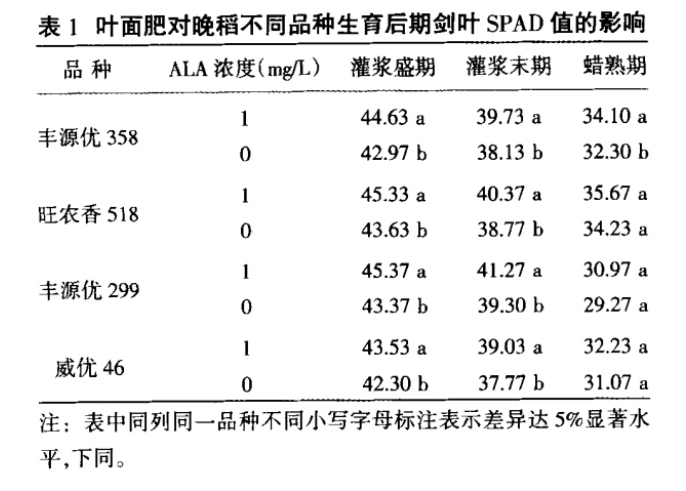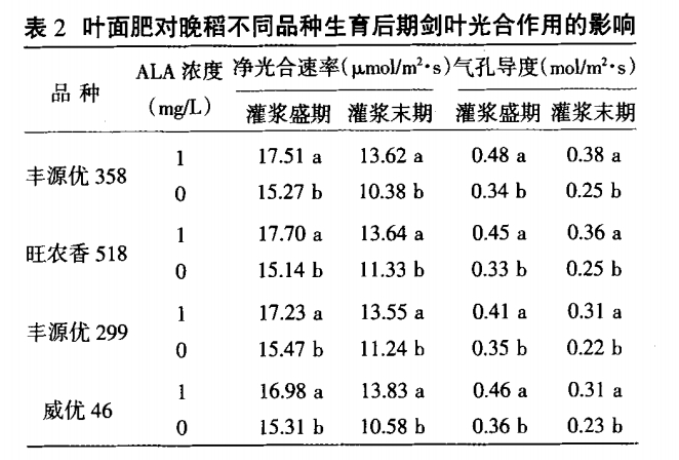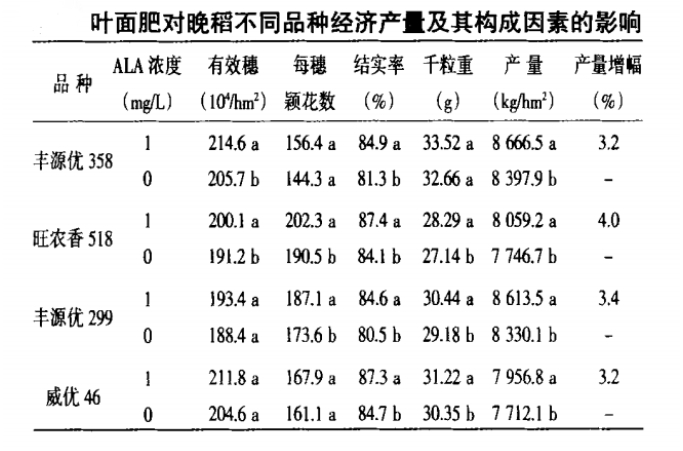This issue brings you the 【 Effects of 5-ALA leaf fertilizer on photosynthesis and yield of hybrid late rice 】

In this study, 5-ALA can increase the yield of hybrid rice by increasing the grain filling rate. Grain filling is an important physiological process in the late growth period of rice. During this period, photosynthetic products are transported to the grain, which affects the seed setting rate and grain weight and yield of rice. Therefore, it is an important way to find out how to slow down the senescence process of rice leaves, improve photosynthesis and promote grain filling rate at the filling stage of rice. A large number of studies have shown that exogenous plant growth regulators are closely related to leaf photosynthesis and grain filling.
5-ALA (5-ALAALA) is a plant growth regulatory substance, is a key precursor of all biological porphyrins such as chlorophyll, ferrous heme, etc., involved in the regulation of chlorophyll synthesis.
In photosynthesis, ALA can increase the photosynthetic accumulation and product transport and distribution of plants by increasing the activity of leaf photochemical reaction and the activity of key enzymes that determine the rate of carbon assimilation in photosynthesis. ALA is widely used in agriculture, low concentration ALA can promote plant growth and increase yield, high concentration ALA is used as herbicide, in addition to increase plant stress resistance, increase fruit color and so on. The effects of ALA on photosynthesis, dry matter accumulation and yield structure of sword leaves in late hybrid rice were studied in order to provide theoretical basis for high-yield cultivation of hybrid late rice.
Materials and methods
1.1 Test materials and treatment Test varieties: 4 hybrid late rice combinations, including Fengyuanyou 358, Wangnongxiang 518, Fengyuanyou 299, Weiyou 46 (Hunan Hybrid Rice Research Center). ALA preparation (Trade name: Yiazhuang, Suzhou Yian Biotechnology Co., LTD.). The experiment was conducted in Changsha Test Base of Hunan Hybrid Rice Research Center in 2012. The soil viscosity and fertility were above medium. The seedlings were cultivated by water, seeded on June 4, transplanted on June 25, the transplanting size was 20cmx30cm, 2 plants/hole, pure nitrogen application was 90kg/hm², and other field management measures were the same as field production. A mass concentration of 1.0mg/L ALA was applied once at the full head stage, and the same amount of water was applied as the control (CK). A random block design was adopted and repeated three times. There were 24 plots in total with an area of 24.0㎡.
1.2 Measurement items and methods
12.1 Chlorophyll content and photosynthesis measurement The chlorophyll content and photosynthesis in the middle of the leaf were measured at the peak, end and wax ripening stages of grout. The chlorophyll content was characterized by SPAD value, measured by portable chlorophyll analyzer (Japan SPAD-502), 10 pieces of chlorophyll were measured in each plot, and the average value was taken as the chlorophyll content of the plot. The intensity of photosynthesis was characterized by photosynthetic rate and stomatal conductance. The American LI-6400 portable photosynthesis measurement system was used to measure 3 pieces per cell, and the average value was used to represent the measured values of each cell. The test was conducted from 9:00 a.m. to 11:00 a.m. on a sunny day.
1.2.2 Dry Matter measurement The dry matter quality of the population was measured at the peak of grout, the end of grout and the wax ripening stage. 3 points were selected from each plot and separated according to the leaves, stem sheath, ear and other organs. The green was killed at 105℃ for 30min, and then dried and weighed at 80℃.
1.2.3 Investigation of yield structure 3d before harvest, 20 stump were randomly investigated in each plot to record the effective spike, and 6 representative rice plants were selected to measure the traits of plant height, spike length, number of spikery per spike, number of grains per spike, thousand grain weight, etc. During harvest, each plot was singled-dried, weighed respectively, and then converted into the actual yield per unit.
1.3 Statistical Analysis of data The statistical and variance analysis of the test data was performed by Excel2003 and SPSS19.0 software.
Results and analysis
2.1 Effects of leaf fertilizer on chlorophyll content of sword leaves at the late growth stage of different varieties of late rice

As can be seen from the above results, in the same variety, the SPAD value of sword leaves treated with ALA was significantly increased compared with the control, and with the extension of growth period, the SPAD value of sword leaves decreased, and the gap between the treatment and the control increased, indicating that ALA has an obvious effect on delaying the decline of chlorophyll content!
2.2 Effects of leaf fertilizer on photosynthesis of sword leaves at the later growth stage of different varieties of late rice

As can be seen from the above results, in the same variety, compared with the control, the net photosynthetic rate and stomatal conductance were significantly increased, and with the extension of growth period, the net photosynthetic rate and stomatal conductance of the leaves decreased, but the reduction difference between the treatment and the control was large, and the decrease of the net photosynthetic rate and stomatal conductance of the treatment was smaller than that of the control from the peak filling stage to the end of filling. This indicates that ALA has a significant effect on maintaining the photosynthesis continuity of the leaf in the late growth period!
2.3 Effects of foliar fertilizer on economic yield and yield structure of different varieties of late rice

As can be seen from the above results, ALA foliar spraying can increase the yield of late rice in different degrees, with an increase of 3.2%~4.0%. Further analysis of yield structure showed that the effective panicle, spikelets per panicle, seed setting rate and 1000-grain weight of the four varieties were increased in different degrees after applying ALA. The seed setting rate of the four varieties was significantly different. This indicates that ALA can improve the seed setting rate and 1000-grain weight of late rice, thereby increasing the yield!
Conclusion and discussion
In this period, the effects of 5 aminolevulinic acid foliar fertilizer on photosynthesis and yield of late hybrid rice were studied. The results showed that:
1. ALA treatment can alleviate the phenomenon of asynchronous grouting and promote the increase of setting rate, thousand grain weight and yield.
2. By studying the relationship between ALA and rice grain gain, it was found that spraying a lower concentration of ALA at the beginning of ear period could significantly increase the rate and weight of rice grain gain.
3. The results showed that ALA treatment significantly increased the grain yield of rice by 3.2% in the late growth period of rice compared with the control
4. After treating rice with ALA, it was found that ALA could delay leaf senescence, slow down the decline of chlorophyll content and photosynthesis, significantly increase the grain and total biomass, and facilitate dry matter accumulation, transport and distribution.
In summary, ALA can significantly increase the rate and weight of rice grain gain; significantly increase rice yield by 3.2%~4.0%; and increase grain filling rate and 1000-grain weight by delaying leaf senility, increasing photosynthesis and accumulation of photosynthetic products in leaves; thus improving the yield of hybrid rice.